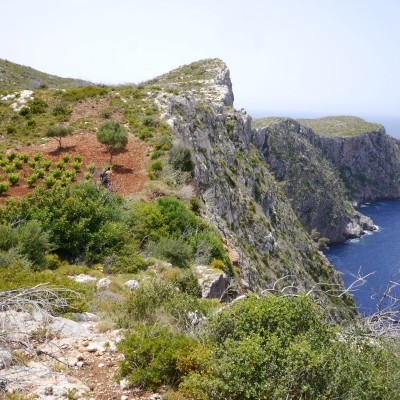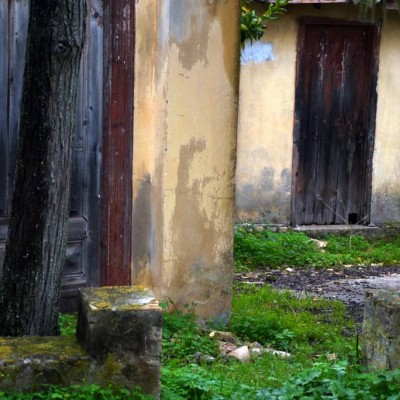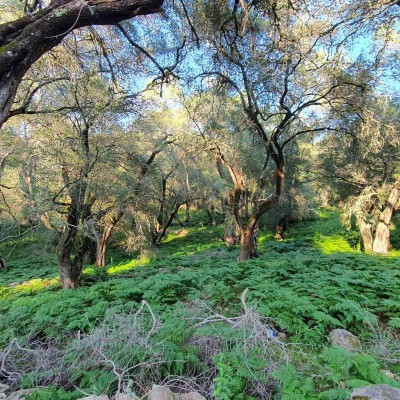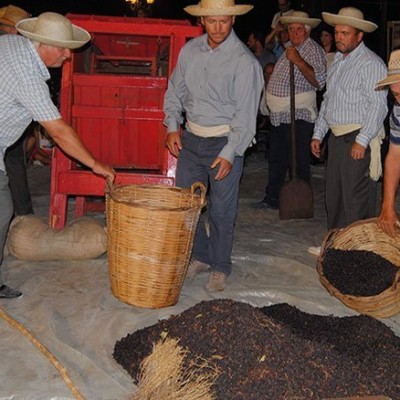Tour of local products
The main products of Zakynthos from the very old times are oil, raisins and wine.
A unique product is ladotyri cheese, which is a gruyere made from sheep's and goat's milk and matures in olive oil. It has a strong, spicy taste, intense aroma and looks a lot like exclusive Swiss and French cheese.
Another local product is the Beloussian onion, which is a unique variety of white-fleshed onion, which reaches a very large size (weight up to half a kilo), which grows where there is a lot of water and has a mild taste.
In the old days, Zakynthian melon was famous, a fruit that in the special microclimate of Zakynthos had a special and pleasant aroma and a very sweet taste.
In Zakynthos, bricks were also produced, which were transported in long wagons to the beach, loaded on boats and brought to the Peloponnese. An entire area on the western side of the city, at the foot of the hill Exintaveloni, consisting of pure clay, was called Kaminia.
A guided tour of the history of the olive tree in Zakynthos and uses of the oil.
With the expansion of Venetian rule in 1485, waves of refugees arrived in Zakynthos from Nafpaktos, Methoni and Koroni, who also brought with them the Koroneika olives groves. This variety, with the lowest trees, which yields more oil and its collection can be extended until January, is known as Liofta or Liofyta and is distinguished from the one that existed before and remained under the name ntopia meaning local. The “Ntopia”, obviously older than the Koroneika or Liofta, are disadvantaged in the production of oil because the fruit as soon as it matures must be collected immediately as it is not preserved on the tree. Another variety with very few old trees scattered (mainly in the hills of Gerakaria), are the so-called tragolies, which after the prevalence of Koroneika did not expand their cultivation.
The cultivation of the olive today spreads all over the island. The gathering starts in October after the first rains and lasts until January depending on the weather conditions. Firstly the “ntopies” are collected, who mature earlier, followed by the collection of Koroneika, starting with those who have little fruit. In the old days, the collection was done by hand. This is how small trees, the “colombes”, are collected today. Today olives are collected only from the trees, after first spreading on the ground with special fabric the “liopana”. They rod the “tsimes”with small sticks that have their upper end bent, the so called “katsourides” or “katsouridelia”. After the shaking is done, all the olives are gathered in a cloth and then cleaned from the small branches with the rake “gravalos” or with the hands.
The inferior oil was used for lighting and for food preservation. They also made soap. From the “liokokia”, the remnants that remained after the oil was removed, began to extract the olive-pomace oil in the 19th century. There was a factory in the area of Kryoneri. Also wood and olive branches were the only energy source for the farmhouse and construction material for various agricultural tools. The tender olive branches were the food of domestic animals. The ash from burning the wood was used to make the lye, a kind of detergent.
The use of oil in the production of soap led to the development of important soap factories in Zakynthos with significant export activity until the beginning of the 20th century.
In modern oil extraction plants, the process of removing the olive oil from the olive fruit, which went through many phases, takes place. Significant decade was the 1950s one, which after the earthquake of 1953, passed from stone pressed era to motor engines with hydraulic presses.
Indicative mills in Zakynthos are:Tour of local products
The main products of Zakynthos from the very old times are oil, raisins and wine.
A unique product is ladotyri cheese, which is a gruyere made from sheep's and goat's milk and matures in olive oil. It has a strong, spicy taste, intense aroma and looks a lot like exclusive Swiss and French cheese.
Another local product is the Beloussian onion, which is a unique variety of white-fleshed onion, which reaches a very large size (weight up to half a kilo), which grows where there is a lot of water and has a mild taste.
In the old days, Zakynthian melon was famous, a fruit that in the special microclimate of Zakynthos had a special and pleasant aroma and a very sweet taste.
In Zakynthos, bricks were also produced, which were transported in long wagons to the beach, loaded on boats and brought to the Peloponnese. An entire area on the western side of the city, at the foot of the hill Exintaveloni, consisting of pure clay, was called Kaminia.Tour of local products
The main products of Zakynthos from the very old times are oil, raisins and wine.
A unique product is ladotyri cheese, which is a gruyere made from sheep's and goat's milk and matures in olive oil. It has a strong, spicy taste, intense aroma and looks a lot like exclusive Swiss and French cheese.
Another local product is the Beloussian onion, which is a unique variety of white-fleshed onion, which reaches a very large size (weight up to half a kilo), which grows where there is a lot of water and has a mild taste.
In the old days, Zakynthian melon was famous, a fruit that in the special microclimate of Zakynthos had a special and pleasant aroma and a very sweet taste.
In Zakynthos, bricks were also produced, which were transported in long wagons to the beach, loaded on boats and brought to the Peloponnese. An entire area on the western side of the city, at the foot of the hill Exintaveloni, consisting of pure clay, was called Kaminia.
A guided tour of the history of the olive tree in Zakynthos and uses of the oil.
With the expansion of Venetian rule in 1485, waves of refugees arrived in Zakynthos from Nafpaktos, Methoni and Koroni, who also brought with them the Koroneika olives groves. This variety, with the lowest trees, which yields more oil and its collection can be extended until January, is known as Liofta or Liofyta and is distinguished from the one that existed before and remained under the name ntopia meaning local. The “Ntopia”, obviously older than the Koroneika or Liofta, are disadvantaged in the production of oil because the fruit as soon as it matures must be collected immediately as it is not preserved on the tree. Another variety with very few old trees scattered (mainly in the hills of Gerakaria), are the so-called tragolies, which after the prevalence of Koroneika did not expand their cultivation.
The cultivation of the olive today spreads all over the island. The gathering starts in October after the first rains and lasts until January depending on the weather conditions. Firstly the “ntopies” are collected, who mature earlier, followed by the collection of Koroneika, starting with those who have little fruit. In the old days, the collection was done by hand. This is how small trees, the “colombes”, are collected today. Today olives are collected only from the trees, after first spreading on the ground with special fabric the “liopana”. They rod the “tsimes”with small sticks that have their upper end bent, the so called “katsourides” or “katsouridelia”. After the shaking is done, all the olives are gathered in a cloth and then cleaned from the small branches with the rake “gravalos” or with the hands.
The inferior oil was used for lighting and for food preservation. They also made soap. From the “liokokia”, the remnants that remained after the oil was removed, began to extract the olive-pomace oil in the 19th century. There was a factory in the area of Kryoneri. Also wood and olive branches were the only energy source for the farmhouse and construction material for various agricultural tools. The tender olive branches were the food of domestic animals. The ash from burning the wood was used to make the lye, a kind of detergent.
The use of oil in the production of soap led to the development of import
A guided tour of the history of the olive tree in Zakynthos and uses of the oil.
With the expansion of Venetian rule in 1485, waves of refugees arrived in Zakynthos from Nafpaktos, Methoni and Koroni, who also brought with them the Koroneika olives groves. This variety, with the lowest trees, which yields more oil and its collection can be extended until January, is known as Liofta or Liofyta and is distinguished from the one that existed before and remained under the name ntopia meaning local. The “Ntopia”, obviously older than the Koroneika or Liofta, are disadvantaged in the production of oil because the fruit as soon as it matures must be collected immediately as it is not preserved on the tree. Another variety with very few old trees scattered (mainly in the hills of Gerakaria), are the so-called tragolies, which after the prevalence of Koroneika did not expand their cultivation.
The cultivation of the olive today spreads all over the island. The gathering starts in October after the first rains and lasts until January depending on the weather conditions. Firstly the “ntopies” are collected, who mature earlier, followed by the collection of Koroneika, starting with those who have little fruit. In the old days, the collection was done by hand. This is how small trees, the “colombes”, are collected today. Today olives are collected only from the trees, after first spreading on the ground with special fabric the “liopana”. They rod the “tsimes”with small sticks that have their upper end bent, the so called “katsourides” or “katsouridelia”. After the shaking is done, all the olives are gathered in a cloth and then cleaned from the small branches with the rake “gravalos” or with the hands.
The inferior oil was used for lighting and for food preservation. They also made soap. From the “liokokia”, the remnants that remained after the oil was removed, began to extract the olive-pomace oil in the 19th century. There was a factory in the area of Kryoneri. Also wood and olive branches were the only energy source for the farmhouse and construction material for various agricultural tools. The tender olive branches were the food of domestic animals. The ash from burning the wood was used to make the lye, a kind of detergent.
The use of oil in the production of soap led to the development of import
• Aristaion, (https://www.aristeon.gr/index-gr.html #home), which also has an olive oil museum and is a traditional family business located in Lithakia. It was founded in 1850. The traditional type with the use of animals for the movement, was replaced with more modern means and later in hydraulic presses. The mill it uses has ISO 22000 certification. In addition, all stages of production are controlled by the organic D.I.O. inspection and certification organisation.
• The Tzavalas olive oil mill in Machairado (https://tzavalasolive.com/en/arxiki/), which combines the passion of the small family business, with the modern facilities that oil the fine Koroneika Zakynthian olives.
• The Nikos and Manolis Vlassopoulos olive press (https://www.preciousoliveoil.gr/poioi-eimaste/), which continue the tradition since 1930, the fourth generation of the Vlassopoulos family, produces the extra virgin olive oil Epsilon Precious.
The Zakynthian vine
In Zakynthos there are 19,000 acres of vineyards with many varieties of which only about 25 account for 80% of the total production. Such are Goustoulidi, Pavlos, Skiadopoulos, Robola, Areti, Asproudi as far as white wines are concerned, the native Avgoustiatis, Robola Mavri, Katsakoulias, Koutsoubeli and Stafidablo, as far as red wines are concerned. The characteristic wine of Zakynthos is the verdea, white dry wine. It was named after its color that leans towards the green. The long aging removes any greenish hue and finally we see a golden-orange color with a kind of pink coating.
The zakynthian raisin is the Corinthian variety. For centuries it was for the Zakynthian economy the so-called "black gold", which offered huge profits. It was exported to many countries, such as Great Britain, for the famous English pudding, Russia, Italy and elsewhere.
In every rural house in Zakynthos there was a wine press called “Linos”. Carved wine presses were found in the Mountain Communities of Zakynthos, Agala, Kambi, Koiliomenos, Orthonies. In several areas of mountainous Zakynthos, carved “linoi” have been found on a rock: location "Kokkino" of the former community of Koiliomenos, area "Andronios" in Agalas and Kambi. The continuation of the technique used by the ancient Greeks for the wine called “protropon”, which was not made from squeezing by feet nor the machine, but the grape must came out simply with the pressure of the grapes that were piled on top of each other.
Indicative wineries in Zakynthos are:
Grampsa Winery (https://ktimagrampsa.gr/)
The winery of the Grampsa family is located in the semi-mountainous village of Lagopodo, at the foot of Mount Vrachona. It was founded by the brothers Christos and Tasos Grampsas in 2011.
Komutu Winery
It is located in the area of Agria Machairadou, among 360 privately owned acres of vineyards and olive trees. The tradition has continued since 1638.
Winery "Oinolpis SA"
It is located in the area of Agria Machairadou and belongs to Timothy G. Christoforos. Wine production began in 1960. The winery also has a fully equipped oenological laboratory.
Leonidas Korianitis Winery
In 1899 a winemaking, distillery and distillery factory was founded by the oenologist Leonidas Korianitis, at Malliaris in the gardens of the Municipality of Zakynthos. He won a gold medal in 1899 at the Prague Exhibition and a gold medal in 1900 at the World Exhibition in Paris.
Efstathios Korianitis Winery
The liquor store of Efstathios Korianitis, which has been operating since 1900, is located at 52 Kalvou Street in Zakynthos Town. His father, Fotios Dion. Korianitis, winemaker, received the gold, silver and bronze prizes at the 11th to the 13th Thessaloniki International Fair.
Zakynthos EAC Winery
The Association of Agricultural Cooperatives has 52 cooperatives on the island. It was founded in 1920. It has three production units. Apart from the traditional varieties of wine, it also produces virgin olive oil and the raisin "black beauty", a black currant with a designation of origin.
Solomos Winery
At the foot of the Venetian Castle, the Solomos-Amountis Family has maintained a farm since 1815. The farm consists of vineyards and olive groves of traditional local varieties and has an area of 150 acres. In the last century, linen, wine cellar and oil press were built for the exploitation of the products. The current owners Anastasios & Dionysios Solomos built a visitable winery under the trade name "Solomos Wines" with modern mechanical equipment, an underground aging cellar and a tasting room.
Callinico Winery
In the village Kallipado was founded in 1918, is the winery Callinico, which belongs to the family Voultsou.




.jpeg)
